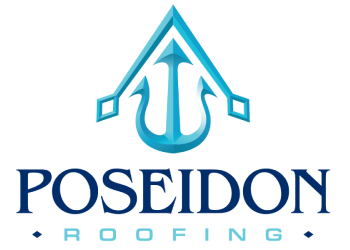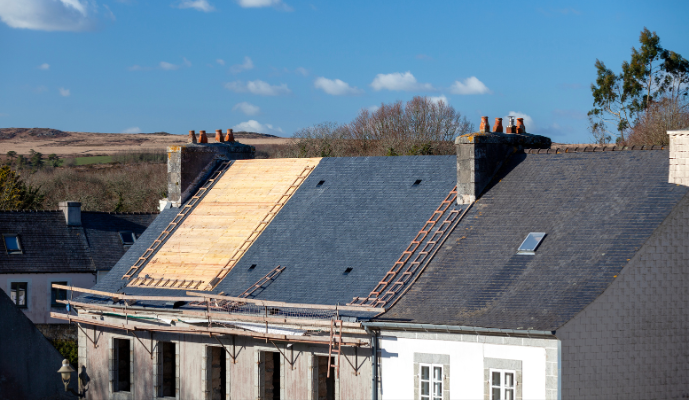A new roof replacement is one of the largest investments a homeowner can make, and it is a decision that carries decades of consequences. A newly installed roof showcasing various materials like asphalt shingles, metal panels, and tile on a residential home will not only protect your property but also enhance curb appeal and improve energy efficiency. Still, every homeowner eventually asks the same question: how long does roof replacement last? The answer depends on roofing material lifespan, climate conditions, installation practices, and the level of maintenance performed over the years.
Understanding the roof replacement lifespan helps homeowners plan budgets, avoid unnecessary repairs, and prevent premature structural damage. At the same time, it ensures that families maximize return on investment while enjoying peace of mind. In this comprehensive guide, you will discover average service lives of popular roofing materials, critical environmental and structural factors that impact durability, visual and performance indicators that signal replacement timing, and practical strategies to extend roof life.
What Is the Average Roof Lifespan by Roofing Material Type?
Roofing materials are not created equal. Each type carries its own strengths, weaknesses, and expected service life. For example, asphalt shingles remain popular for their affordability, but they cannot match the endurance of slate or metal roofing. A comparison of roofing materials including asphalt shingles, metal roofing, clay tiles, and slate showcases their unique characteristics and longevity.
| Roofing Material | Expected Lifespan | Primary Durability Factor |
|---|---|---|
| Asphalt Shingles | 15–30 years | Granule retention and UV resistance |
| Metal Roofing | 40–70 years | Corrosion resistance and coating quality |
| Clay & Concrete Tile | 50–100 years | Compressive strength and weight support |
| Slate Roofing | 75–200 years | Natural stone density and weatherproofing |
| Wood Shingles/Shakes | 25–40 years | Moisture management and rot resistance |
| Flat Roof Membranes | 15–25 years | Seam integrity and ponding water prevention |
This variation underscores the importance of choosing materials that align with climate conditions, budget, and long-term goals. Let’s explore each type in more detail.
How Long Do Asphalt Shingles Last? Types and Durability Factors
Asphalt shingles are the most common residential roofing material. They consist of asphalt, fiberglass, and mineral granules, offering moderate durability at an affordable price. Yet, the roof replacement lifespan varies widely depending on shingle type.
-
3-Tab Shingles: 15–20 years
-
Architectural Shingles: 20–30 years
-
Luxury or Laminated Shingles: 30–50 years in favorable climates
Regular inspections to detect granule loss, curling edges, or cracking can prevent shingle failure. Adequate attic ventilation also reduces brittleness from excessive heat, helping asphalt shingles last closer to their maximum lifespan.
Interestingly, research by Applied Research Associates, cited by the Insurance Institute for Business & Home Safety, found that asphalt shingles older than ten years may not withstand winds above 100 mph. This reveals that homeowners in storm-prone regions should weigh asphalt’s affordability against potential vulnerabilities.
What Is the Durability of Metal Roofing? Steel, Aluminum, Copper, and Zinc Compared
Metal roofing offers one of the best balances between cost and longevity. Panels or shingles crafted from steel, aluminum, copper, or zinc provide distinct benefits:
-
Steel (Galvanized or Galvalume): 40–60 years, excellent wind and hail resistance
-
Aluminum: 50–70 years, ideal for coastal climates due to corrosion resistance
-
Copper: 75–100+ years, develops protective patina that enhances durability
-
Zinc: 80–120 years, self-healing surface minimizes maintenance
Metal roofs reflect solar heat, reducing thermal stress cycles that weaken roofing materials over time. A study by the Metal Construction Association confirmed that 55% aluminum-zinc coated steel roofs can last more than 60 years when installed correctly, validating the impressive longevity of this material.
How Long Do Tile Roofs Last? Clay and Concrete Tile Lifespan Explained
Clay and concrete tile roofs bring both durability and beauty. Clay tiles typically last 50–80 years, while concrete tiles range from 40–60 years. Their heavy weight requires strong framing, but their density offers outstanding resistance to hail, fire, and UV exposure.
Periodic underlayment inspections and resealing of joints protect against water infiltration beneath tiles. With proper care, tile roofs easily outlast generations of homeowners, making them a wise investment for those who prioritize both durability and timeless appearance.
What Is the Life Expectancy of Slate Roofing? The Longest-Lasting Option
Slate roofing sets the gold standard in terms of longevity. With an average roof life expectancy of 75 to 200 years, slate often outlasts the structure it protects. Its natural stone composition resists water absorption, frost, and fire.
However, slate requires expert installation and significant structural reinforcement due to its weight. While the upfront cost is high, the durability and elegance of slate make it one of the most cost-effective long-term roofing solutions.
How Durable Are Wood Shingles, Shakes, and Flat Roof Materials?
Wood shingles and shakes, especially cedar and redwood, provide an attractive natural finish. With consistent treatment against fungi and moisture, they can last 25–40 years. Flat roofs, on the other hand, rely on synthetic membranes such as EPDM, TPO, or PVC.
-
Wood Shingles/Shakes: 25–40 years
-
EPDM Membrane: 20–25 years
-
TPO/PVC Membranes: 15–20 years
Routine inspections of seams and treatments to prevent moss buildup are essential for both wood and flat roof systems to achieve their maximum service life.
What Are the Key Factors That Affect Roof Replacement Longevity?
Beyond material choice, several external and structural factors determine whether a roof reaches its full potential. These include climate, installation quality, maintenance, ventilation, and roof pitch.
How Does Climate and Weather Impact Roof Lifespan?
Climate significantly influences how long a roof replacement lasts. UV rays, extreme heat, ice, hail, and heavy rainfall accelerate deterioration. For example, asphalt shingles become brittle under intense sun, while freeze-thaw cycles can cause tiles to crack.
Proper material selection for your climate ensures durability. Metal excels in hail-prone regions, tile resists heat in desert climates, and asphalt remains practical in milder areas.
Why Is Professional Roof Installation Critical for Durability?
Even the most expensive materials fail without proper installation. Incorrect flashing, poor underlayment placement, or improper fastener spacing can cut a roof’s service life in half. Hiring certified contractors ensures manufacturer guidelines are followed, protecting warranties and preventing premature issues.
How Does Regular Maintenance Extend Roof Lifespan?
Maintenance plays a central role in maximizing roof replacement lifespan. Annual inspections, gutter cleaning, moss removal, and sealant renewals can prevent minor issues from turning into costly failures. Neglect often shortens the life of even the highest-quality materials.
What Role Does Attic Ventilation and Insulation Play in Roof Health?
Attic ventilation reduces heat buildup, while proper insulation minimizes moisture problems. Both directly impact roofing material lifespan. Studies reveal that unvented attics can reduce shingle life by 10–24%, with extreme cases showing reductions up to 50%.
How Does Roof Pitch and Drainage Influence Durability?
Steeper slopes shed water more effectively, reducing ponding and algae growth. Flat roofs require precise membrane installation and drainage solutions to avoid early failure. Good design and consistent maintenance are crucial to extending roof service life in low-slope structures.
When Should You Replace Your Roof? Signs and Indicators of Roof Failure
Identifying roof failure early saves money and prevents structural damage.
-
Visual Indicators: granule loss, curling shingles, cracked or missing tiles, sagging roof deck
-
Performance Indicators: frequent leaks, poor energy efficiency, recurring mold, ice damming
Once these signs appear, repairs may only offer temporary relief, and full replacement becomes the most reliable solution.
How Can You Maximize Your Roof’s Lifespan? Actionable Tips for Homeowners
Practical steps every homeowner can take include scheduling bi-annual inspections, keeping gutters clear, trimming overhanging branches, and addressing minor flashing failures immediately. More advanced methods such as reflective coatings, upgraded sealants, and infrared inspections further strengthen roof protection.
What Are the Cost and Value Considerations of Long-Lasting Roofing Materials?
While durable materials such as slate and metal cost more upfront, their longer lifespan often lowers the annualized cost. For example, slate roofing may cost $15–$30 per square foot but delivers protection for over a century, making it more affordable per year than cheaper asphalt that requires multiple replacements within the same timeframe.
Frequently Asked Questions About Roof Replacement Lifespan
Homeowners often ask how often roofs should be replaced. Asphalt typically lasts 15–20 years, while slate can exceed 100. Factors such as poor installation, inadequate ventilation, and harsh climate conditions may reduce these averages. Maintenance practices like inspections and sealant renewals significantly extend longevity.
Roofing Services Provided by Poseidon Roofing
For homeowners seeking reliability, Poseidon Roofing provides expert roof replacement, repair, and maintenance services tailored to each material type. Whether you are installing a new metal system, repairing asphalt shingles, or upgrading to slate or tile, Poseidon Roofing delivers professional workmanship that ensures durability, energy efficiency, and maximum roof replacement lifespan. With skilled crews and attention to detail, they help homeowners protect their investment and achieve long-lasting peace of mind.


